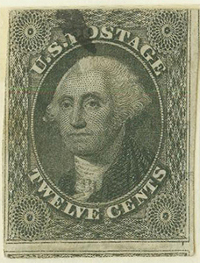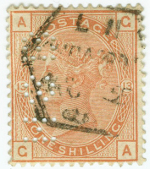
Discussion - Member to Member Sales - Research Center

Discussion - Member to Member Sales - Research Center

What year?
thank you.


Login to Like
this post
It appears to me that this is Great Britain, Queen Victoria, 1887, likely Stanley Gibbons #200. The green ink which was the original colour was not well suited to holding its colour in water, and hence the very pale appearance.
It is also a perfin which does not help in seeing the image clearly and crisply.
JTH

1 Member
likes this post.
Login to Like.
Do you know the number in Scott Catalog? I received those as a gift
is "Perfin" the 'holes' in the stamp? (why did they make holes?!)

Login to Like
this post

08:38:47pm
""Perfin" the 'holes' in the stamp? (why did they make holes?!)"
Yes the perfins are the holes in the stamp. They are collected by many people are usually stand for the company or organization that used the stamp. If you look at it through the back you can probably identify the letters and might be able to do a search and find the name of the company, I am not an expert on GB stamps so I can't tell you the Scott number for this British stamp but I'm sure someone else can do that. Welcome to the club!!

Login to Like
this post
This is the stamp you have, Scott #113.
Perfins stands for Perforated Initials.


Login to Like
this post
found #113 - does the 'Perforated Initials' means the stamp looses all of its value?
thank you

Login to Like
this post
No, stamps that are perfins are quite collectible, by specialists.
Some collectors will indeed discount the value, if they are looking for an example that has "no holes" and is in Very Fine (VF) condition.
Value, though, is in the eye of the beholder!
The initials on your copy appear to be C L + CCo. There are other websites which might help in identifying the company that used these initials. A catalogue can be found and purchased from the Perfin Society in the UK, but I do not have access to one.
Stamps were "perfined" by companies, often to prevent employees from using them for personal purposes rather than company business.
Here is another example of SG #200 or Scott #113 which is not a perfin and is postmarked March 1888 and shows colour that is somewhat closer to the original.
JTH


2 Members
like this post.
Login to Like.
Unforunately CL+CCo is not listed in Tomkins Catalogue of GB Perfins.
It is an unusual perfin.
Perfins with a "+" sign are not common.

Login to Like
this post
It may have survived because it is an unusual perfin.

Login to Like
this post
Hi,
The perfin CL/+/CCo was used by Copestake, Lindsay, Crampton & Co., London.
It's listed in the Tomkins catalogue 8th edition.

3 Members
like this post.
Login to Like.
A Google search for Copestake, Lindsay, Crampton & Co., London turns up a fascinating and detailed history of a London-based lace, textile, and clothing firm which was a going concern for about 150 years from the 1820s until 1970.
The URL for this history is: http://www.coulthart.com/avery/company-p ...
Here is a short excerpt, minus the footnotes:
From an 1875 London City Directory
“Copestake, Moore, Crampton & Co. wholesale warehousemen for lace & sewed muslins, scotch & manchester goods, cambrics & lawns, curtains, silks, crapes, gossamers, velvets, gloves, stays, artificial flowers, feathers, millinery, babylinen, ladies’ outfitting, mantles, shawls, costumes, haberdashery, men’s outfitting, umbrellas & parasols …”
Major changes in the company’s leadership occurred during the fourth quarter of the 19th century. Apparently after Samuel Copestake Sr. died in 1874, his only child, Samuel Jr., seems to have taken over his father’s part of the business although he became a barrister and was never listed as a warehouseman. Two years later George Moore died in 1876 with no children to carry on his role in the company. Another man named James Hughes became involved in the business around this time and by 1878 its name was incorrectly listed in a newspaper as Copestake, Crampton, Hughes & Co. Then in 1879, after Thomas Hill Crampton died, his three sons, Alfred, Henry and Percy took over his position in the firm. The firm’s name was listed as Copestake, Hughes, Crampton & Co. in city directories from 1880 until at least 1884. In 1883 and 1884 the business registered over 50 designs for various textile products using this new name. After Mr. Hughes’s death in 1888, a Mr. Lindsey joined the firm and it was renamed again, this time it became Copestake, Lindsey, Crampton & Co. which is how it was listed in an 1888 newspaper article and in an 1890 city directory, a name it continued to be listed as in newspapers through 1902.
Moderator - Link active
(Modified by Moderator on 2025-03-23 06:13:44)

4 Members
like this post.
Login to Like.
Nice summary jthurd!
The first form of the company name that you mention (including "Moore") is shown on this early underprint:

This is on a penny red and is my only example of a British underprint from this period.
These are listed in SG's QV Specialised catalogue.

4 Members
like this post.
Login to Like.

re: help
It appears to me that this is Great Britain, Queen Victoria, 1887, likely Stanley Gibbons #200. The green ink which was the original colour was not well suited to holding its colour in water, and hence the very pale appearance.
It is also a perfin which does not help in seeing the image clearly and crisply.
JTH

1 Member
likes this post.
Login to Like.

re: help
Do you know the number in Scott Catalog? I received those as a gift
is "Perfin" the 'holes' in the stamp? (why did they make holes?!)

Login to Like
this post
Back when I had a bunch! I think, therefore I am - I think! Descartes, sort of!
20 Mar 2025
08:38:47pm
re: help
""Perfin" the 'holes' in the stamp? (why did they make holes?!)"
Yes the perfins are the holes in the stamp. They are collected by many people are usually stand for the company or organization that used the stamp. If you look at it through the back you can probably identify the letters and might be able to do a search and find the name of the company, I am not an expert on GB stamps so I can't tell you the Scott number for this British stamp but I'm sure someone else can do that. Welcome to the club!!

Login to Like
this post

re: help
This is the stamp you have, Scott #113.
Perfins stands for Perforated Initials.


Login to Like
this post

re: help
found #113 - does the 'Perforated Initials' means the stamp looses all of its value?
thank you

Login to Like
this post

re: help
No, stamps that are perfins are quite collectible, by specialists.
Some collectors will indeed discount the value, if they are looking for an example that has "no holes" and is in Very Fine (VF) condition.
Value, though, is in the eye of the beholder!
The initials on your copy appear to be C L + CCo. There are other websites which might help in identifying the company that used these initials. A catalogue can be found and purchased from the Perfin Society in the UK, but I do not have access to one.
Stamps were "perfined" by companies, often to prevent employees from using them for personal purposes rather than company business.
Here is another example of SG #200 or Scott #113 which is not a perfin and is postmarked March 1888 and shows colour that is somewhat closer to the original.
JTH


2 Members
like this post.
Login to Like.
07:18:47am
re: help
Unforunately CL+CCo is not listed in Tomkins Catalogue of GB Perfins.
It is an unusual perfin.
Perfins with a "+" sign are not common.

Login to Like
this post
08:00:42am
re: help
It may have survived because it is an unusual perfin.

Login to Like
this post

re: help
Hi,
The perfin CL/+/CCo was used by Copestake, Lindsay, Crampton & Co., London.
It's listed in the Tomkins catalogue 8th edition.

3 Members
like this post.
Login to Like.

re: help
A Google search for Copestake, Lindsay, Crampton & Co., London turns up a fascinating and detailed history of a London-based lace, textile, and clothing firm which was a going concern for about 150 years from the 1820s until 1970.
The URL for this history is: http://www.coulthart.com/avery/company-p ...
Here is a short excerpt, minus the footnotes:
From an 1875 London City Directory
“Copestake, Moore, Crampton & Co. wholesale warehousemen for lace & sewed muslins, scotch & manchester goods, cambrics & lawns, curtains, silks, crapes, gossamers, velvets, gloves, stays, artificial flowers, feathers, millinery, babylinen, ladies’ outfitting, mantles, shawls, costumes, haberdashery, men’s outfitting, umbrellas & parasols …”
Major changes in the company’s leadership occurred during the fourth quarter of the 19th century. Apparently after Samuel Copestake Sr. died in 1874, his only child, Samuel Jr., seems to have taken over his father’s part of the business although he became a barrister and was never listed as a warehouseman. Two years later George Moore died in 1876 with no children to carry on his role in the company. Another man named James Hughes became involved in the business around this time and by 1878 its name was incorrectly listed in a newspaper as Copestake, Crampton, Hughes & Co. Then in 1879, after Thomas Hill Crampton died, his three sons, Alfred, Henry and Percy took over his position in the firm. The firm’s name was listed as Copestake, Hughes, Crampton & Co. in city directories from 1880 until at least 1884. In 1883 and 1884 the business registered over 50 designs for various textile products using this new name. After Mr. Hughes’s death in 1888, a Mr. Lindsey joined the firm and it was renamed again, this time it became Copestake, Lindsey, Crampton & Co. which is how it was listed in an 1888 newspaper article and in an 1890 city directory, a name it continued to be listed as in newspapers through 1902.
Moderator - Link active
(Modified by Moderator on 2025-03-23 06:13:44)

4 Members
like this post.
Login to Like.

re: help
Nice summary jthurd!
The first form of the company name that you mention (including "Moore") is shown on this early underprint:

This is on a penny red and is my only example of a British underprint from this period.
These are listed in SG's QV Specialised catalogue.

4 Members
like this post.
Login to Like.

